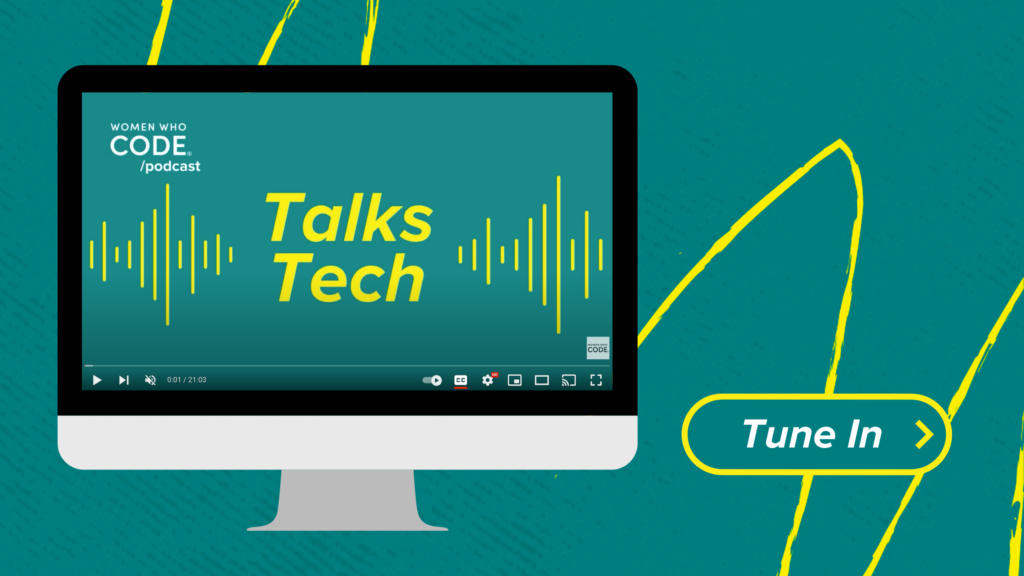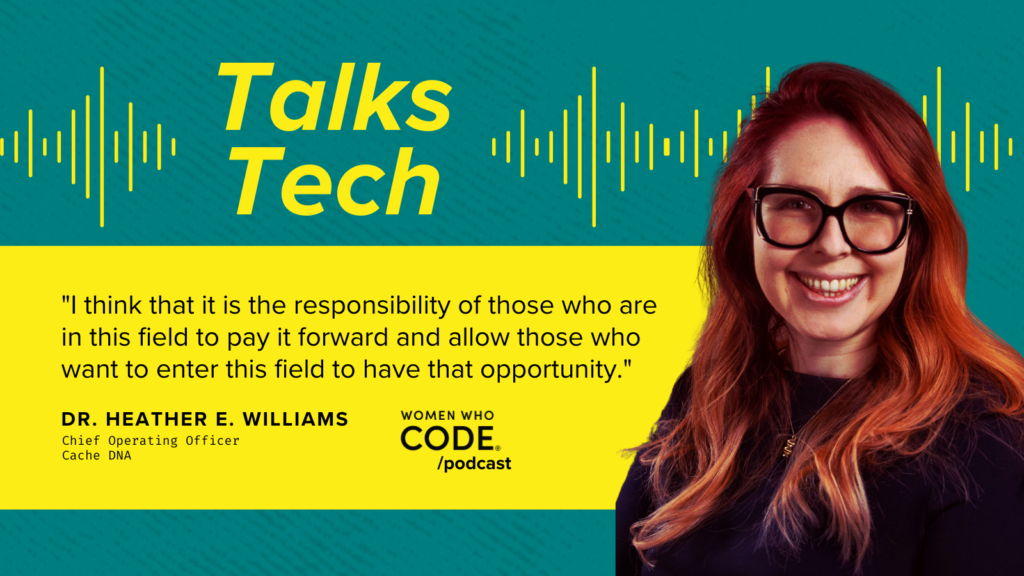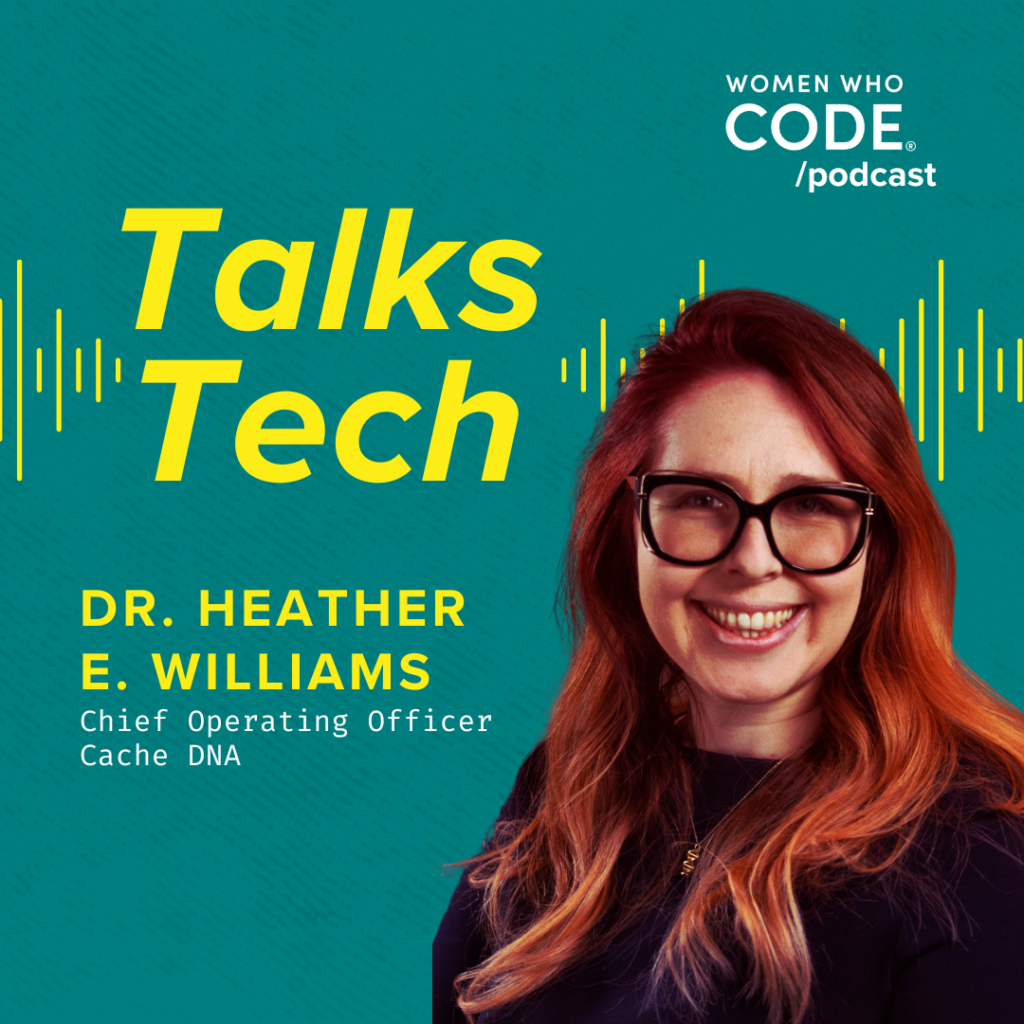
Talks Tech #62: From Medical Laboratory to Pathology & Laboratory Medicine Executive

This article has been adapted from the recording of Talks Tech #62.

Dive into a WWCode Talks Tech episode with Dr. Heather Williams, Chief Operating Officer at Cache DNA. Discover the vital link between clinical genetics and coding as Dr. Williams shares insights into her career journey and the transformative impact of computational skills in healthcare. Explore the complexities of genomic analysis and gain practical resources for integrating coding into clinical genetics.
I'm currently the Chief Operating Officer at Cache DNA in the San Francisco Bay area of California in the United States. I am a board-certified clinical laboratory geneticist, and I've been trained across Europe and the United States. I have had the opportunity to work at several amazing institutions, including King's College Hospital London and New York Presbyterian and Columbia University Medical Centers, in addition to Flagship Pioneering, Tempus Labs, and my current role. I've been working in laboratory medicine and pathology for nearly two decades and recently completed my executive MBA at the Yale School of Management.
I have expertise in transitioning labs to demonstrate the quality and reliability of their clinical service, and I also advocate for the governments for health equity in genomic testing. I enjoy mentoring women in science and biotechnology and the standardization of genomics in informed clinical care. So today, I'm going to talk to you a little bit about my job and my journey, and I believe that coding is essential to the future of this field. So, what exactly is a clinical laboratory geneticist? A clinical laboratory geneticist is responsible for analyzing the genetic information from a biological sample, whether that be a blood sample, bone marrow, cerebral spinal fluid, you name it; if it comes from a human, it could be isolated and interrogated using the DNA and RNA that we all hold for clinical informed care. But how does this happen?
It's not as simple as I just outlined, where you take a sample, and you go all the way to a result.
There's no machine that you can just put it on, and the result comes out. Instead, the critical role of those who have computation skills is to make an impact in this field and drive diagnosis, discoveries, and treatments for these patients. So, I'm going to explain why I believe these coding skills are increasingly essential for not only clinical geneticists but many of the other clinical genomic professionals in the field who make an impact. So I've kind of just dug immediately into my field of genetics, but just to break it down a little bit further, clinical genetics has a role across healthcare. Everyone has those base pairs that we have in our genome, ATCG, and they are essential for all the analyses that I'm going to share and talk about with you today. The field of genomics is pretty nascent. Some of us are old enough to remember the completion of the human genome. Although that was announced nearly 21 years ago today, it is not a project that was completed when it was announced. It is an iterative process that continues today. That's why I think this is such an exciting topic to talk about: how we can make an impact by growing our skills and computing to look at those nucleotides. And so I am talking in the context of the human genome and a clinical laboratory and making an impact on patients.
But I want to make it very clear that those who have these skills don't necessarily have to make an impact in the clinic. Those skills are transferable across research development, the biopharma industry, you name it; this data is so important to making discoveries that may ultimately be a part of clinical care. So, how is this coding used in large genomic data sets? I will briefly show you a slide that kind of walks you through how we get from a human genome all the way to a result that could make an impact on patient care. What you see here diagrammed is a sequencing machine. Most often, people might refer to this as MiSeq HiSeq; the company Illumina produces the majority of these around the world. Essentially, it produces the sequence that we analyze and calls variance, sometimes also referred to as mutations, but the preferred nomenclature is variance these days. Then, there is this bottleneck in this image; that's where the skills of computation are just so critical. You can have all of this information about the ATCG base pairs, but if you can't do something with it, there is no impact on the ability to map that information to a disease setting, a response to a drug, the possibility of developing a new drug, and also the frank possibility of the absence of any findings that might be clinically relevant.

I've gone through this bottleneck image that steps you through what many might refer to as a wet lab component and a dry lab component to these analyses. Wet being the manipulation, you might automatically imagine someone with gloves and a pipette in their hands manipulating that sample. Often, the dry lab component is what we're primarily focused on today, which is those skills and the ability to align the sequence to a reference genome and make findings about variants that exist in that sample versus a reference genome. So when we talk about having a role like this, what does it mean to understand programming languages and search around cyberspace to get this information integrated into the genome and make an impact? It can be a fast-paced and exciting career, but it is so important for the clinical interpretation of inherited diseases. And it is such a bigger picture of an impact you can make.
When you think about individual patient stories, you can think about how you started early in your career, learning the technology and being a key part of a puzzle with an important purpose as a coder. So, with that, it's important to understand the functional requirements of someone with computation skills. But on the other end of that, it's so important to be a part of an interactive career field, and you have to seek information across the global community of those who are focused on discoveries. I believe that it's a fit for anyone who really enjoys problem-solving, tracking projects, and ensuring that the skills, education, and experiences they have are committed to the highest level of computation and testing in terms of patient discoveries.
It's certainly a new field, and you can learn every day and continue to create even more modern tools to innovate and discover more genetic findings for this community. I want to give a great example of how coding knowledge can benefit the genetic analysis that's going on for a patient outcome. So, I'll tell you the story of a patient who was in the NICU as an infant and had a rapid test. Now, generally speaking, when you get a genome analysis, it does take quite a significant amount of time, but instead, this test was offered with a rapid turnaround time. There were bioinformaticians, variant scientists, and clinical geneticists who were involved in the analysis of this baby's genome using a variety of different diagnostic tools and software where they took the genome information and that of the baby's mother and father and were able to find a variant in the genome that was different.
That allowed for a diagnosis and treatment of that baby where there would otherwise be a terrible outcome, and instead, that baby is healthy today. So, this case example that I just walked through occurs in NICUs across the US, and there are many ongoing projects, such as Project Baby Bear in California and Project Baby Deer in Michigan. You get the concept that all of these efforts are focused on taking this information from the genome, analyzing it with computation, and essentially impacting patient lives.
Now, I've not gotten into the great detail of what those skills look like because that's a great opportunity for the end of this talk, where I will give you a preview of where you can get the skills to make an impact. Instead, what I'd like to do is transition a little bit from, okay, we've gone ahead and we've got coding skills, we can translate these ATCGs into knowledge, but then what do we do there? It doesn't simply stop at, okay, I found a variant, and I used my skills. Instead, you have to leverage a lot of other information that you need to know as someone in this field. So, like I said, when discussing having these computation skills, that's simply not enough. You also have to integrate your skills as someone who can take data man, populate it, and apply that to your knowledge of biology. I am now showing a slightly comedic slide because I'm trying to demonstrate to you the highly complex nature of the skills you need as someone who can code and make an impact in treatments, discoveries, research, and development. Once we've gotten this variant, you can see what is displayed as a kind of spider web with several different boxes of data that make an impact. All of this has to be mapped together.
So, the variant has to be mapped to data from the patient. It has to be mapped to a clinical history. It has to be mapped to a database that a hospital or an institution has. It also has to be mapped to a family history, a phenotype, considerations of your technique, considerations and limitations of your coding skills. It also has to be mapped to the burden of this variant in the population around the globe. I hope you're getting an idea of the spirit of the complexity here.
On this slide, you'll also see I'm comparing this to a very famous meme from Always Sunny in Philadelphia, where our friend Charlie is at a bulletin board, and there are red lines, and they are attached pens. He is trying to convince someone of the complexity of the investigation he is responsible for. So I like to use that meme as a great analogy to the complexity that exists once you've been able to use your skills as a coder and link that to all of the data that exists in the world about that variant, about the genomes, and make an impact for a patient. So I've talked a little bit about how the genome was completed over 20 years ago, and it seems like that might be a closed book, but that's not necessarily true.
It's important to recognize that discoveries and treatments in genetics are only looking up, and coding will continue to be integral to these developments. Everyone is going to need to have those skills to continue to make an impact on the field of genetics. I'd like to leave you with some resources to help you understand and become skilled in the practical applications of clinical genetics. Understanding that all of us listening now have diverse backgrounds, I'll start with some opportunities for those who might still be in high school and are thinking about medicine or coding opportunities that might fit their future education.

So, one of the programs I'll call out is at the Fred Hutch Cancer Center in Seattle, Washington. And they have a program that is open now. This allows those in high school to learn about coding in genetics online. It's primarily focused on cancer biology, and it is a fun, hands-on activity that you can do to learn about what it means to have one of these roles in science. Now, there are lots of other opportunities that might make sense for those who have completed their undergraduate experience their graduate experience; they may be looking for a job transition out of an industry they're already in, but what I think is particularly important is that everyone can benefit from an understanding of the genetic analysis that results from coding because this is our genome, this is our healthcare.
And so I implore you to seek out resources even if you think you will need more time to make a career change. Maybe it's this program I mentioned at Fred Hutch that's a fit for you. There are also online courses through Johns Hopkins University through Coursera that you could take. And, of course, you can always reach out to someone who is in this field and ask them questions about what it means to perform their job and what skills or programming or even just books you should be reading about this field and this topic, if it's something that you want to get involved in. So with that, we've gone over several aspects in terms of the future and the past of this field and how anyone who has these skills or is seeking out these skills can make an impact.
And I want to leave you with a couple of final thoughts. I believe anyone who sets their mind to learning about something can do it. And it is the responsibility of those in this field to pay it forward and allow those who want to enter it to have that opportunity. And with that, I welcome the opportunity for any of you to contact me on LinkedIn. You can find me there. I'm always happy to receive a message, and I reserve time on my calendar to spend 10 to 15 minutes with those who have a keen interest in this field to help them get started. Thank you so much for listening to my career journey and the impact those with coding skills can make on clinical genetics.I look forward to connecting with you.